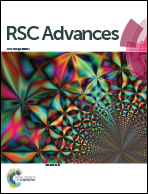Morphology-dependent photoelectrochemical properties of multi-scale layered Bi(C2O4)OH†
Abstract
In this work, a facile hydrothermal process is employed to synthesize multi-scale layered Bi(C2O4)OH compounds (microrods, nanorods, nanowires and straw sheaves), which can be well controlled by simply tuning oxalate source, ethylene glycol/water (EG/W) volumetric ratio, H2C2O4/Bi(NO3)3 molar ratio, hydrothermal temperature and duration. Further, we have mainly investigated the transformation process from one-dimensional (1D) nanostructures to 3D straw sheaves of Bi(C2O4)OH. Moreover, it is found that the photoelectrochemical properties of Bi(C2O4)OH are greatly morphology-dependent: for the degradation of rhodamine B (RhB), on the one hand, the photocatalytic activity of nanorods is 2.45, 1.79 and 1.46 times higher than those of microrods, nanowires and straw sheaves, respectively; that is, the apparent reaction rate constants (k) are 0.0053, 0.01298, 0.00726, and 0.00888 min−1 for microrods, nanorods, nanowires and straw sheaves, respectively. On the other hand, the capacitance values of nanorods, microrods, nanowires and straw sheaves samples are 21.00, 19.00, 20.37 and 17.50 mF cm−2, respectively, which is in agreement with their photocatalytic activities.


 Please wait while we load your content...
Please wait while we load your content...